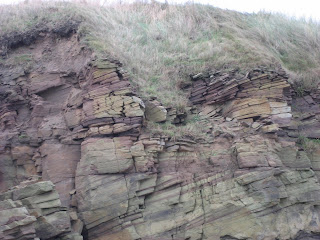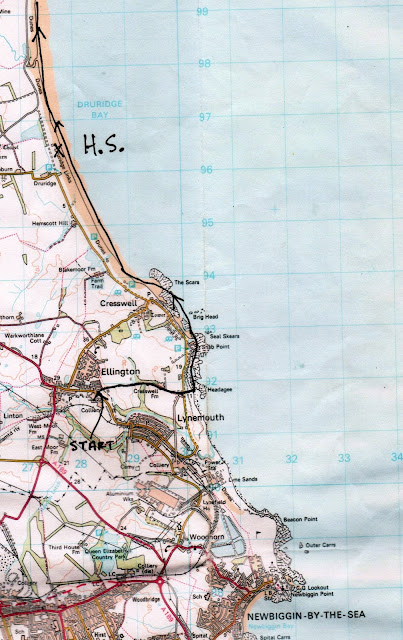How to beat Black Friday..........November 27th.(Northumberland Coast)
There are many things that come out of America that I like, rock n' roll, jazz and cowboy films, plus a lot of other films. There are some things we have imported from the US I don't like, such as Halloween and Black Friday, that day when the stores open early and people fight over TV sets.
One of the lady columnists for The Times offered ten ways of avoiding the madness;
1. Stay at home, 2, Stay at home.....................10. Stay at home.
With over 500 years of collective wisdom eight gadgies came up with our own way of avoiding mayhem in the malls; go for a walk.
A full squad out too; Dave, Brian, Ben, Harry, Ray, John C., John H., and me (Note the Oxford comma)
Sadly the long awaited walk from Middleton in Teesdale (now abbreviated to M i T) has had to be postponed again because we are promised heavy rain in the afternoon so the octet have opted for another walk up the Northumberland coast, from Ellington to Amble.
Ellington is an ex mining village close to the sea. Until 2005 the coal it produced powered the Lynemouth power station which in turn powered the Alcan smelter across the road. The mine has closed, the smelter has become the home of small industry. One of the miners has become MP for the area.
Memorial statue to the men and mine at Ellington.
To get to Ellington from Newcastle take the Northumberland Spine road (A189) and follow signs through Lynemouth. As you enter Ellington there is a road on the right with parking space.
This week's car park in Ellington.
It is an easy walk, no map required but should you wish it is covered by OS Landranger 81 Alnwick, Morpeth.
It was, for November, a mild and pleasant morning with a light wind from the south west, on our backs all the way. Continuing down the road where we had parked we past Cresswell Farm, the buildings were being converted into homes. A large dog greeted us.
He is playing for Newcastle United next week, won't let go of the ball.
At the end of the track we crossed the dunes and tuned north. The beach in this area is covered with rocks of different sizes and seaweed, making it slippy. The beach is covered in places by coal dust that seeps out of the seams. The rocks are probably interesting for geologists and geography teachers, layers of sand stone.
Today's Geology lesson.
But soon we were back on land as we walked through Cresswell, the spring where watercress grows. Most of the houses appear to be holiday homes, apart from this one.
Cresswell tower and a strand of barbed wire.
Beyond Cresswell we were back on the beach, walking the curved Druridge Bay, about five miles of it. Not much bird activity on the beach today, sanderlings and gulls, plus a cormorant although Ben and Dave claimed a kingfisher as we had walked towards the sea from Ellington.
After about five miles walking it was time to hunker down below the sand dunes for a Herbie Spot.
Today's goodies included Cherry Bakewells, Tracker bars, ginger biscuits from Ben, chocolate flapjacks and mincemeat flavoured cake from Mrs A. The stuff you put in mince pies, not meat.
The blocks are left overs from WWII, designed to stop tanks landing
A slightly choppy sea
Miles of golden sands
Lunch over we continued north, leaving the beach at Low Hauxley. There is a nature reserve here, access from the land side. Several hides and a centre under reconstruction after an act of pointless vandalism set the old one on fire.
Hauxley Nature Reserve centre under construction
From Hauxley we followed the narrow footpath that climbed up and down the dunes. Eventually we reached Amble, Northumberland's Friendliest port and found the bus stop.
Amble
Warkworth Castle is not far from Amble.
As we waited in the shelter for the bus the promised rain arrived, heavy and driven by the wind. Had we spent much longer over lunch we would have been very wet gadgies. Back in Ellington we hurriedly debooted and headed for the Three Horse Shoes at Horton. A large pub with a large selection of beers including Abbott, Golden Shoes and Hadrians Border.
The three Horse Shoes,good pub, good beers, good food. Five barrells.
The Matrix MMXV YYYY
steps miles
Nako 26413 10.39
LIDL3D 23895 10.18
etrex 11.1
Dave's LIDL3D 23660 10.88
" USB 23271 11.38
Nako 24272 11.87
John C 11.3
Brian 11.4
Contains OS data, copyright. Crown copyright and database right 2015.
There are many things that come out of America that I like, rock n' roll, jazz and cowboy films, plus a lot of other films. There are some things we have imported from the US I don't like, such as Halloween and Black Friday, that day when the stores open early and people fight over TV sets.
One of the lady columnists for The Times offered ten ways of avoiding the madness;
1. Stay at home, 2, Stay at home.....................10. Stay at home.
With over 500 years of collective wisdom eight gadgies came up with our own way of avoiding mayhem in the malls; go for a walk.
A full squad out too; Dave, Brian, Ben, Harry, Ray, John C., John H., and me (Note the Oxford comma)
Sadly the long awaited walk from Middleton in Teesdale (now abbreviated to M i T) has had to be postponed again because we are promised heavy rain in the afternoon so the octet have opted for another walk up the Northumberland coast, from Ellington to Amble.
Ellington is an ex mining village close to the sea. Until 2005 the coal it produced powered the Lynemouth power station which in turn powered the Alcan smelter across the road. The mine has closed, the smelter has become the home of small industry. One of the miners has become MP for the area.
Memorial statue to the men and mine at Ellington.
To get to Ellington from Newcastle take the Northumberland Spine road (A189) and follow signs through Lynemouth. As you enter Ellington there is a road on the right with parking space.
This week's car park in Ellington.
It is an easy walk, no map required but should you wish it is covered by OS Landranger 81 Alnwick, Morpeth.
It was, for November, a mild and pleasant morning with a light wind from the south west, on our backs all the way. Continuing down the road where we had parked we past Cresswell Farm, the buildings were being converted into homes. A large dog greeted us.
He is playing for Newcastle United next week, won't let go of the ball.
At the end of the track we crossed the dunes and tuned north. The beach in this area is covered with rocks of different sizes and seaweed, making it slippy. The beach is covered in places by coal dust that seeps out of the seams. The rocks are probably interesting for geologists and geography teachers, layers of sand stone.
Today's Geology lesson.
But soon we were back on land as we walked through Cresswell, the spring where watercress grows. Most of the houses appear to be holiday homes, apart from this one.
Cresswell tower and a strand of barbed wire.
Beyond Cresswell we were back on the beach, walking the curved Druridge Bay, about five miles of it. Not much bird activity on the beach today, sanderlings and gulls, plus a cormorant although Ben and Dave claimed a kingfisher as we had walked towards the sea from Ellington.
After about five miles walking it was time to hunker down below the sand dunes for a Herbie Spot.
Today's goodies included Cherry Bakewells, Tracker bars, ginger biscuits from Ben, chocolate flapjacks and mincemeat flavoured cake from Mrs A. The stuff you put in mince pies, not meat.
The blocks are left overs from WWII, designed to stop tanks landing
A slightly choppy sea
Miles of golden sands
Lunch over we continued north, leaving the beach at Low Hauxley. There is a nature reserve here, access from the land side. Several hides and a centre under reconstruction after an act of pointless vandalism set the old one on fire.
Hauxley Nature Reserve centre under construction
From Hauxley we followed the narrow footpath that climbed up and down the dunes. Eventually we reached Amble, Northumberland's Friendliest port and found the bus stop.
Amble
Warkworth Castle is not far from Amble.
As we waited in the shelter for the bus the promised rain arrived, heavy and driven by the wind. Had we spent much longer over lunch we would have been very wet gadgies. Back in Ellington we hurriedly debooted and headed for the Three Horse Shoes at Horton. A large pub with a large selection of beers including Abbott, Golden Shoes and Hadrians Border.
The three Horse Shoes,good pub, good beers, good food. Five barrells.
The Matrix MMXV YYYY
steps miles
Nako 26413 10.39
LIDL3D 23895 10.18
etrex 11.1
Dave's LIDL3D 23660 10.88
" USB 23271 11.38
Nako 24272 11.87
John C 11.3
Brian 11.4


























































